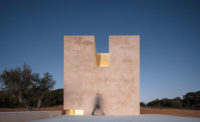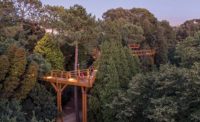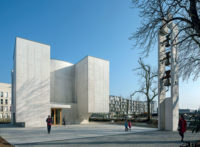When famed Portuguese architect Álvaro Siza, a Pritzker Prize laureate, now 86, began to design a small chapel for a remote mountainside in South Korea, he drew, as he recalls, “on centuries of marvelous church buildings.” His project condenses the basic elements of those traditions and, in so doing, transforms them with his characteristic quirky grace.
Additional Content:
Jump to credits & specifications
Facing east down a hillside, the white stucco chapel is composed of three volumes that step up in height. Frontmost is a peculiar pediment, columnless, with an exaggerated cantilever. Hovering over the entry, the building reinterprets a Neoclassical portico with a dash of contemporary structural swagger. The two succeeding volumes make up the sanctuary itself: rising to a steep triangular peak, the first opens into a taller flat-roofed space over the altar, much the way a church nave meets the crossing. Where the two volumes join, an off-kilter opening—like a misplaced oculus or rose window—cuts into a high spandrel. The aim is to cast a moving spot of daylight across the altar, with the rays filtering through a thin pane of alabaster rather than glass. With just these few bold, theatrical moves—the two-stage spatial sequence and framing, the penumbra, and the almost hidden source of light—the architect seeks to achieve a luminous, spiritual atmosphere.
The 450-square-foot chapel is one of three structures Siza designed with a longtime collaborator, architect Carlos Castanheira, for the 75-acre Saya Park, in North Gyeongsang Province. Created by retired businessman Jaesung Yoo, this ambitious project is open to the public. Siza and Castanheira’s Art Pavilion there opened in April, but their Observation Tower is yet unbuilt. Along the park’s wooded trails, Yoo has selected special places for contemplative meditation—a bench in a clearing or overlooking a view, or near a group of sculptures. His other structures on-site include an open-air music pavilion beside a mountain stream. The chapel, built for his wife, who is Catholic, stands in a far corner of the park, near a family burial plot marked by two boulders and a pair of ancient trees.
Yoo first came to Siza with the idea of realizing a project never intended to be built, a museum commissioned for a Madrid exhibition in 1992. The architect demurred, suggesting a new design, but Yoo insisted. “It was very amusing,” Siza confides. That scheme, only slightly altered, is now the Art Pavilion, used for installations and events. With long, curving, branchlike wings, it was originally conceived to feature Picasso’s “Guernica,” the famous (and unavailable) painting, which Siza has replaced with his own marble, wood, and Cor-Ten-steel sculptures and ceramic-tile murals.
Like the Art Pavilion, the chapel is built of poured concrete, white-stuccoed on the exterior, but with the rough texture left by the board formwork exposed inside. The altar—a simple rectangular block—is of Portuguese marble; and the cross, tabernacle, benches, and pivoting entry door were all crafted in Portugal, of Afzelia, an African hardwood that Siza first used for his Boa Nova Tea House in 1963.
The architect has designed several churches, including Santa Maria in Marco de Canaveses, Portugal (1996), and a private chapel for the Quinta Santa Ovidio estate, projects that Yoo visited before this work began. (Some of Siza’s other recent religious structures include his chapel in Algarve, Portugal, and his Anastasis Church, near Rennes, France.) Like much of that earlier work, the Saya Park chapel plays with archetypal forms. Outside, the structure is as sharply drawn and proportioned as a Renaissance tempietto. Inside, without losing this elemental clarity, its spatial unfolding and raw concrete seem closer to the Romanesque’s dark, primitive masonry interiors. Yet for all the history this work invokes, it is unmistakably of the present, fresh and surprising—the performance of a master.
CreditsArchitect: Álvaro Siza and Carlos Castanheira, with Rita Ferreira, Diana Vasconcelos, Luíza Felizardo, Nuno Rodrigues, Filipa Guedes (project team)
Engineering: HDP (structural)
Client: Jaesung Yoo
Size: 450 square feet
Cost: withheld
Completion date: September 2018 |
SpecificationsCustom cabinetry and woodwork Serafim Pereira Simões Sucessores
Stone altar Sousa Mármores
Lighting THPG
Door bolt CBC |










Post a comment to this article
Report Abusive Comment